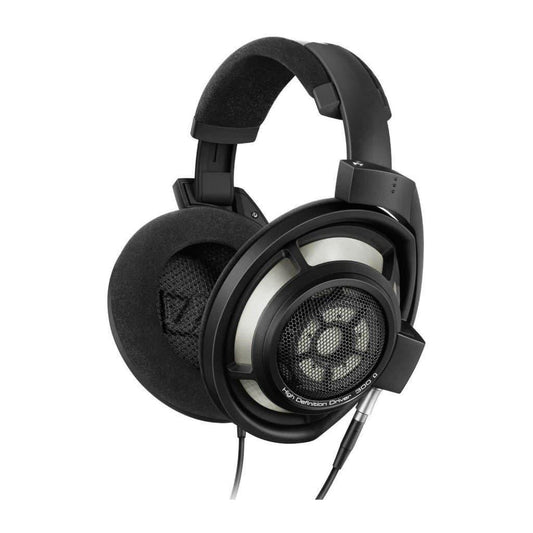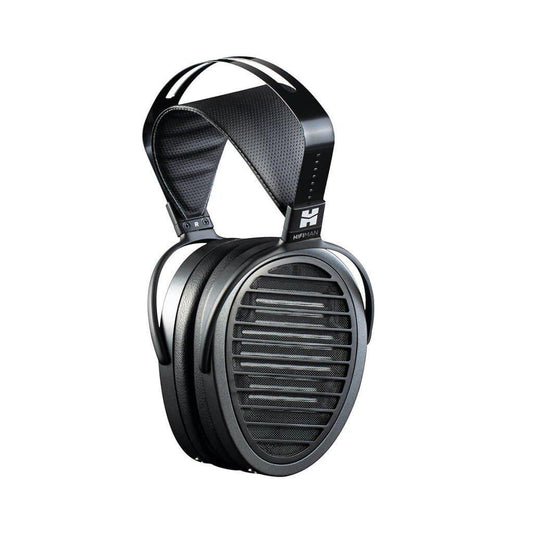Sennheiser HD800S: Revisiting a Legend

Introduction
The Sennheiser HD800S needs little introduction. Released at the end of 2015 as a follow-up to the legendary HD800 (itself released in 2009), the HD800S remains Sennheiser’s modern flagship. With it comes a number of technical changes to improve upon the HD800’s sound while retaining the qualities that made it an instant classic. Today’s article will be a look back at the HD800S as it stands at the end of 2022 and see if it still lives up to its lofty name.
Sennheiser HD 800S Headphones
Product Summary
What we like
- Exceptional resolution, detail retrieval, and coherency
- Great soundstage and imaging
What we don’t like
- Slightly thin tuning
- Weak bass dynamics

Build and Comfort
Sennheiser products are well-known for their build quality and the HD800S continues that tradition. Its construction is a mix between metal and plastic with a sensible distribution of both materials for rigidity and weight. The plastic used here feels particularly sturdy and of high quality. I find the HD800S to be quite comfortable as it is fairly lightweight and doesn’t have a very strong clamp force. However, I’m not the biggest fan of its headband as I do start to develop a pressure sport after a bit of time. There isn’t too much padding in it to spread the weight. Likewise, the stock earpads are made of a velour material and are very thin, some of the thinnest pads I’ve come across for a headphone. It doesn’t affect the comfort much for me as the low clamp force means the cups don’t push too much against my ears.
As for accessories, the HD800S comes with two 6.35 mm cables and a massive box. Both of these cables terminate in an unusual 2-pin-like connectors at the headphone end. I’m not the biggest fan of this connector. You need a scary amount of force to remove it the first time and doesn’t seem to have any more merit than a simple 3.5 mm termination or using a mini-XLR.
Source(s): Ferrum Audio ERCO Balanced DAC/amp
Sound and Frequency Response

Measurement of the Sennheiser HD800S on an industry standard GRAS 43AG measurement rig. The dotted black line represents the Harman target, a reference frequency response developed using consumer preferences. The red line is how the HD800S measures. Effectively, this shows how significantly the headphone’s frequency response deviates from the target. Note however that the target is highly smoothed and strict adherence to the Harman target is not necessary for a headphone to sound good.
Bass
When you look at the bass on the graph, you can see that the HD800S does start to slope off in the subbass and isn’t quite as flat as some of the higher end planar headphones. Obviously, the HD800S’ bass is meant to be “neutral”. In practice, I find it rather lacking. Its dynamic ability can be weak. At times, it’s almost as if it’s puffing air rather than producing a bass response with substance or weight. Bass is punchy and light with a significant midbass focus that’s confident with every note. In some instances there can be a bit of heft with the kick drum and floor toms but it’s really up to the recording quality of the track. In other words, don’t get this headphone if you like a bit of bass. Synths, drums, bass guitar, double bass, and other bass heavy instruments will lack a satisfying presence. While subbass rumble and texture can be heard, it’s almost there for completion’s sake courtesy of the HD800S’ resolving ability rather than as a musical note.

On the upside, the bass quality is as expected of a reference grade headphone. It’s clean, tight, defined, and responsive. Transient response is incisive but not overly sharp. Decay is quick and notes don’t linger too much. While I don’t care too strongly for planar vs. DD differences, the HD800S does sound characteristically like a dynamic driver. Or at least, it’s hard to imagine it not being one. That’s not to say it’s a good or bad thing, just something to keep in mind if you have a strong preference.
Mids
The midrange of the HD800S follows that reference mindset established in the bass. I think the best way to describe it is as distant - both spatially and emotionally. It’s like if you were a neutral observer watching the music instead of being immersed in it. Tuning wise, other than starting its pinna gain rise at 1.5 kHz instead of 1 kHz, the HD800S generally follows the shape of the Harman target in the upper mids. Instruments sound correct and vocals are never lost. Both male and female vocals perform equally well and there’s an exceptional sense of clarity in the midrange that effortlessly tackles any instrument it comes across. However, I wouldn’t call its tonality the most pleasing. The midrange doesn’t really draw me in to keep listening. It eschews the typical audiophile trappings of being “warm” or “lush” and keeps me at an arm's length away. While the HD800S may be classified as thin, it’s not overwhelmingly so. Instruments do maintain their underlying body but it’s the upper harmonics that are prioritized. The best example would be the acoustic guitar. Though the body of the guitar builds up a full, rich sound, I hear more of the strum and picking of the strings instead of the bodied tone of the wood.

Treble
If you’re new to the scene, there’s actually a little bit of history around the creation of the HD800S. The original HD800 is infamous for its treble spike around the 6 kHz and an ingenious community member found a way to tame it AKA the SDR mod). Sennheiser took notice of the reception to this mod and developed the HD800S to address the treble. You can see this in the frequency response graph - around the 6 kHz region there is a bit of a hump but it’s not a sharp peak in any way. Finally, its upper treble extension gives it an airy, spacious sound.

Practically, how does this translate into different instruments? Well, hats and cymbals generally sound quite balanced. While they tend to be on the splashy side, they’re still crisp with attack and shimmer as needed. Though the treble is definitely a bit bright, it doesn’t overtly call attention to itself and does a good job of blending in with the rest of the track. It’s not a “spicy” treble. It’s apparent that Sennheiser has done quite a bit of work to minimize the treble peaks of the HD800S as when it does hit those peaks in a recording, it’s tame and quickly subsides. It’s like it knows it’s overstepping its boundaries and immediately corrects itself. As such, though there is sibilance where I expect it to be, I find it very tolerable. Importantly, while there is an upper treble peak around the 11 kHz region like so many other bright headphones, this one is rather tame. I have a number of tracks that can get very harsh there and the HD800S is downright manageable. Sharp, yes. Painfully so? no.
Love our in-depth reviews?
We test and review hundreds of headphones every year. Sign up to get the latest news, reviews, guides, and more in your inbox. Join the 60,000+ like-minded audio lovers who love our newsletter!

Presentation
Alright, so the tonality of the HD800S isn’t the best. But that was never its claim to fame. Where the HD800S solidified its place in headphone history is in its technical prowess.
When people think of the HD800S, most tend to immediately gravitate towards its immense soundstage. Some would even go so far as to say it’s so large it’s exaggerated. I don’t find it so. It’s still very much a headphone. It excels in horizontal width and has a respectable height but stage depth is comparatively limited. Unlike the higher end HiFiMan headphones, the HD800S doesn’t feel quite as open - as in, it doesn’t leak as much sound out the back. What’s more interesting is its imaging. For the vast majority of headphones, music radiates from a central point in your head, the HD800S has two diffusion points, one at each ear. This might seem obvious - it’s a headphone (duh), but practically speaking, it has significant ramifications for the sound presentation of the HD800S. Instead of having a central “hotspot” of music, there’s a relaxed central image so it doesn’t sound so “in of your head” like many headphones do. To me, this is what gives the HD800S a speaker-like presentation, as cliche as that may be. When I switch from listening to my speakers to the HD800S, the transition is a lot more seamless, a lot less obvious that I’m on headphones now.

The second thing that the HD800S is renowned for is its resolving ability. Back when it was first released some went as far as to call it the most resolving headphone available. While I would hesitate to call it that, the HD800S’ resolution is really its crowning feature, moreso than its staging. It’s so effortlessly coherent with the intricacies of every note laid bare before you. Likewise, the layering and instrument separation is superb. The HD800S simply does not get bogged down in any way.
Let’s use an example. Here is Lullaby by IU. There are six notes in the first five seconds. Five chords and a single note. Beyond the notes themselves, with most headphones you can hear the mechanical noises of the acoustic piano - the pedaling of each chord, the bottoming out of the keys, the motion as they spring back into position. If your headphone is really good, you might be able to hear how the felt interacts with the keys. But with the HD800S, I can hear the resonance of nearby strings, the sympathetic vibrations of keys that weren’t even played. Can I hear this on other headphones? Yes, when I look for it. But not until I first noticed it with the HD800S and now know it’s there. And this is what I mean by coherency. These notes were always there, hidden as it may be. It’s not like the HD800S magically synthesized new musical information out of thin air. But it’s the combination of its resolution and coherency that allows me to understand what I’m hearing rather than glancing over it as yet another sound in the overall recording. Even now, almost a decade after its release, the HD800S easily competes at the top for being one of the most resolving headphones in the market.
Comparisons
Sennheiser HD600

It might seem strange to compare the HD800S with the HD600 but I think it’s a fair discussion since there may be some looking to the HD800S as a potential upgrade down the line. In general, the HD800S handily beats the HD600 on all counts except for two: tuning and bass dynamics. Needless to say, the HD600’s tuning is one of the best in the headphone space and is simply much more inviting than the HD800S. While its bass isn’t anything to write home about, it’s more of a testament of how weak the dynamics of the HD800S’ bass is that it doesn’t improve upon the HD600’s. But when it comes to other technical parameters, it’s a significant step up. The HD600 is painfully enclosed in comparison to the HD800S and that “central hotspot” is extremely apparent. The HD600 just feels stuffy when compared to the HD800S. The superb resolution of the HD800S peels back the veil and clarifies everything the HD600 puts forth.
HiFiMan Arya

I reviewed the HiFiMan Arya a while ago here and had a comparison to the HD800S in that article. My thoughts remain the same, with the exception that the more I listen to the HD800S, the more impressed I am by its coherency and resolution compared to the Arya. Initially I had thought they were at about the same level, with an edge to the HD800S. But now the HD800S is the clear winner for me even if the absolute difference is still fairly small.
Otherwise, I’ll restate the three points I have when it comes to picking between them:
- Do you want a more excited tuning? Then take the Arya for its vivid character. The HD800S is a more neutral, flattened experience while the Arya has a bit of a V-shaped nature to it.
- Do you want a planar or dynamic driver? Each has their merits when it comes to the bass response. The Arya’s planar bass is more tightly defined but doesn’t have the same dynamic decay the HD800S has.
- Do you want a proven, reliable build? Then take the HD800S for Sennheiser’s legendary build quality.
Hifiman Arya Headphones | Stealth Magnets Edition

Should You Buy It?
Yes, but only if you greatly value the strengths it brings to the table. There’s a reason the HD800S has cemented its place in headphone history. Though it may be an old headphone, the HD800S is still nearly unparalleled in its areas of excellence. But that’s the catch. It only excels at what it does. It’s a specialist headphone that will strongly appeal to a subset of customers while alienating another. Personally, I can see myself daily driving the HD800S as a speaker replacement for general use but if I really want to be immersed in musical enjoyment, I’d likely swap out to something with a little more of that fun factor.


